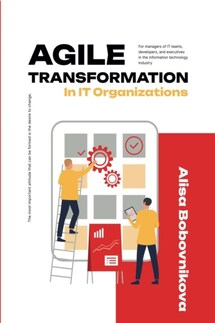Agile Transformation in IT-organizations - страница 6
• Waterfall model forces developers involved in the project to be disciplined and to stay within the plan. If necessary, a management body responsible for decision-making is added to the general model, while performers are required to work within the system framework15;
• Flexibility in the early stages. Changes in early phases can be made immediately and with minimal effort, since they are not backed up by code. Thus, the customer and the contractor have a significant time margin for a radical change in the concept of software work;
• Focus on deadlines and finances. Due to the fact that each stage completely outlines the contour of the future software, all developers understand their role, the boundaries of work and deadlines. This allows you to cooperate with the customer knowing the real cost of development and makes, therefore, the project model attractive.
In the 1970s, Royce's ideas were relevant. But after almost 50 years, the cascade development method is less and less suitable for IT:
• non-adaptive software structure. At the first stages, the waterfall model can be flexible, but if problems in the overall structure are identified during the testing phase, this entails deplorable consequences in the form of disrupted deadlines and even customer failures;
• ignores the end user. The lower the process progresses in the waterfall, the less the role of the customer in it, not to mention the users he represents. Making any changes to the functionality of the software starts the entire chain of stages anew, so the products obtained by the cascade model are far from targeting the mass user;
• later testing. It is here that mistakes made at each of the stages are most often identified. More flexible methodologies use testing as a fundamental operation that occurs continuously. Waterfall, on the other hand, admits low qualifications of employees at each stage and poor quality of execution, because with late testing, problems cannot be solved fundamentally, only with the help of "patches".
Let's fix both approaches pros and cons:
Everything seems to be transparent, but in practice the question often arises which methodology to apply in each specific case. This scheme helps us mostly to make the right choice:
It turns out that the cascade methodology is an excellent solution in terms of deadlines and reporting, but very weak in terms of quality.
Despite the fact that these 3 points are increasingly rare in real practice, the cascade model will be popular and in demand for a long time because of its clear organization. This means that any professional developer should understand its basic principles and be ready to exist within the framework of this approach.
LET'S SUMMARIZE WHAT WE’VE LEARNED IN THIS CHAPTER:
Agile and Waterfall are the most common but opposite to each other software development approaches. While commending the waterfall methodology, it is necessary to move forward and look ahead, addressing contemporary challenges here and now. Agile is just what you need for this. We have also learned, that:
• software development methodologies should be evaluated using project management triangle;
• Agile methodology gained great popularity and changed software development forever by now;
• Waterfall or Cascade methodology is still in demand, so developers should be ready to exist within this approach.






